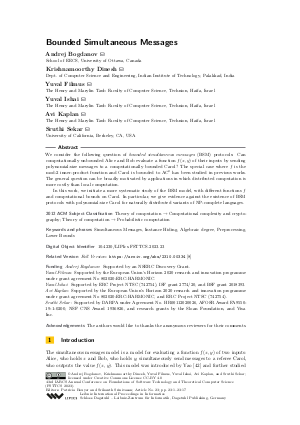@InProceedings{bogdanov_et_al:LIPIcs.FSTTCS.2023.23,
author = {Bogdanov, Andrej and Dinesh, Krishnamoorthy and Filmus, Yuval and Ishai, Yuval and Kaplan, Avi and Sekar, Sruthi},
title = {{Bounded Simultaneous Messages}},
booktitle = {43rd IARCS Annual Conference on Foundations of Software Technology and Theoretical Computer Science (FSTTCS 2023)},
pages = {23:1--23:17},
series = {Leibniz International Proceedings in Informatics (LIPIcs)},
ISBN = {978-3-95977-304-1},
ISSN = {1868-8969},
year = {2023},
volume = {284},
editor = {Bouyer, Patricia and Srinivasan, Srikanth},
publisher = {Schloss Dagstuhl -- Leibniz-Zentrum f{\"u}r Informatik},
address = {Dagstuhl, Germany},
URL = {https://drops-dev.dagstuhl.de/entities/document/10.4230/LIPIcs.FSTTCS.2023.23},
URN = {urn:nbn:de:0030-drops-193961},
doi = {10.4230/LIPIcs.FSTTCS.2023.23},
annote = {Keywords: Simultaneous Messages, Instance Hiding, Algebraic degree, Preprocessing, Lower Bounds}
}

 Creative Commons Attribution 4.0 International license
Creative Commons Attribution 4.0 International license


